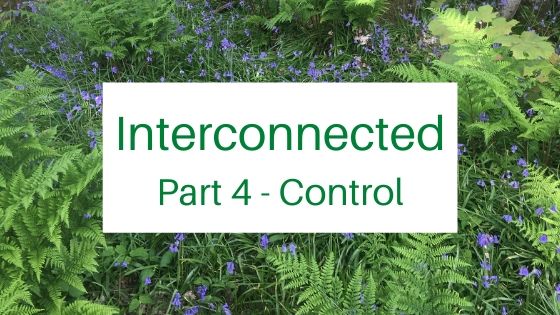“Nature is not a place to visit. It is home.”
Gary Snyder
Control is an interesting word often used in a derogatory manner and associated with dominance and power over. Through the years I have learned a new way of understanding the interconnected nature of control and the behaviour associated with it.
Succession
About 15 years ago I completed a permaculture design course and so began a new relationship with the wee patch of nature around my home. One of the things which most stood out for me was the very wonderful Ed Tyler teaching us about succession. He described how there is a natural order to the progression of plants in temperate conditions, all leading towards the establishment of forest.
Forest gardening
A light went on inside me and I started an edible Forest Garden. Instead of “fighting” nature as I had for the decades before, I decided to work with it instead. If she wants to be a forest, let her. Oh but that is so much easier to say than to do!
The perfect garden
Brainwashed by modern living and too many instant gardening TV programmes I wanted the perfect garden. Hammock hanging under beautiful mature trees, arches covered in roses, patios full of pots of flowers. There would be beautiful furniture, fairy lights, clear paths, no weeds and lots of fruit and veg laid out beautifully.
I wanted it to look neat, tidy and ordered. I longed to lie around in said hammock on a hot days reading novels, hand hanging loosely over the side as I slipped off into blissful afternoon snoozes.
None of this could happen, of course, until said order had been established. I needed it under control!
The weeds
It never was. All I ever seemed to do was fire fight nettles, docks, couch grass, creeping buttercup and the dreaded bindweed. I could never get I top of the weeds so felt constantly overwhelmed and disappointed with my far from perfect garden. This external brainwashing about what it should be dovetailed nicely with my own inner weeds, both required a different kind of make-over.
Controlling behaviour
Lack of a warm loving childhood environment, coupled with fear, left me without some of the basic building blocks for life. The unreliable, inconsistent nature of my parents created a deep feeling of not being safe in the world. This lack of safety permeated my life like a fungal growth reaching into every nook and cranny.
One of the patterns I developed is often negatively referred to as controlling behaviour. “Your such a control freak, so anal, trying to tell everyone what to do, ordering everything and everybody around, having to always be in charge, be right.”
I’ve heard it all and now I largely ignore it. My training as a therapist helped me to understand how unkind and misled these terms are.
Not safe
When I lapse into controlling behaviour, which I do, or I see it in my clients, friends or family I know I am witnessing someone, who very likely, does not feel safe in the world. In an attempt to sooth discomfort and manage anxiety we display behaviour perceived as control.
The illusion that we can feel safe by controlling our external environment is fed by our culture and media. TV programmes promise that an instant makeover of home or garden will transform lives for the better, we will feel amazing.
Inside job
Sometimes this manipulation of the outside helps, temporarily. In my experience however, it is an illusion. No amount of external management will heal the inner problem. Instead I would get caught up in anxious patterns of control, micro-managing my home, garden, family and myself in an attempt to sooth what troubled me.
I felt out of control and unsafe. My childhood experiences had formed limiting beliefs which made me scared of interacting with the world. I feared being shot down in flames at any minute thinking I would be exposed as bad, wrong, or defective in some way. You, the world would ridicule or reject me and then what?
My inner garden
Like my inner garden my outer one required the same understanding and acceptance. The two have trotted along together, all a work in progress.
I gradually realised that safety really is an inside job. That expression though dished out willy nilly, holds a truth. I wouldn’t find safety in instant fixes, one minute wonders, or miraculous makeovers, lovely as they are.
Practising daily routines creates stability. Through regularly tending to the hurt places I slowly learned to keep them more weed free. Working with therapists helped resolve deeper traumas and childhood difficulties. Slowly I cleared patches and created space for other things. I built inner stability and stronger foundations from which to meet the outer world.
My garden also needs this sort of attention.
A plan
With help from Ludwig and Cesaria from Earthways on Skye my husband and I explored our dreams and desires for our little patch. Together we formulated a loose 3-4 year plan.
Almost instantly I felt relieved. Instead of worrying about the overgrown “mess” I now know – no need to fret Mairi, it will all happen in good time. There is an order to things. If I follow the rhythm of regular tasks a certain stability is maintained. Priorities begin to show themselves while the bigger jobs can be arranged when needed.
Parallels
This unfolding Forest garden parallels so much of my inner journey to heal. It is an eco-system following a successional journey. I can use my energy to fight against that, try to manage and control it all or I can learn another way. I can see that this habitat has an impetus towards something grand and bountiful, a flourishing forest.
It knows what to do. As do I. When I let go of trying I can, instead, accept that my nature is also in a continuous flow towards something. I have an impulse to grow and develop. Trusting the unfolding of my own human life is amazing.
Support
If I support myself with regular practices like meditation, walking in nature, time alone, good nutrition and so on, life is so much more manageable. Just like the weeding in the vegetable beds some order is maintained.
Issues which require deeper work show themselves as physical or mental symptoms: dis-ease. Sometimes I can tackle them straight away at other times I need to make a plan. For more challenging concerns I seek the support of trusted friends and/or I pay for the guidance of an expert, my therapist.
Just as the guidance of Ludwig and Cesaria helped me see my garden in a different light my therapist can help me see my inner troubles from a different perspective.
Now my garden and I live much more comfortably together, one reflecting the other. Instead of constantly battling to control and contain I see a work in progress. Alive and teeming with life my garden shows me the abundance, vibrancy and beauty of life untethered and I love it.
“Nature is loved by what is best in us.”
Ralph Waldo Emerson
![]()




This is so well constructed and well written, what an excellent parallel between the garden and the inner life. Funnily enough I am going to go out and do some gardening today, in a parallel with my life I am trying to leave big gaps between the plants instead of jamming them all in together. I will put a bit of mulch down which is used a lot here to help conserve water in the soil, not sure if it’s used in the UK. I will have a think abut what the mulch is in my inner life, what is helping create space? I wonder whether my inner mulch has any wee plants poking through like the garden bed does? Will they be replaced with a plant of my choosing or will I let nature take its course, both within and without? Lots to ponder in a new light.